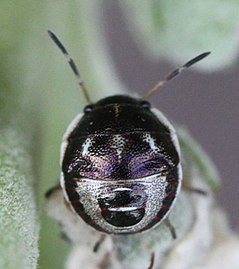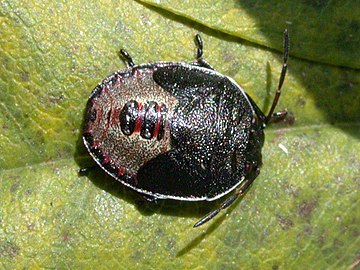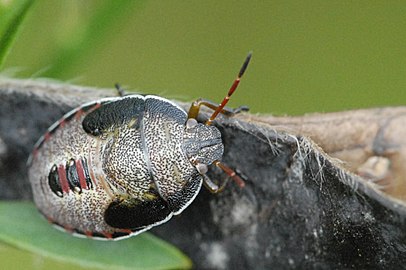
Pentatomidae is a family of insects belonging to the order Hemiptera, generally called shield bugs or stink bugs. Pentatomidae is the largest family in the superfamily Pentatomoidea, and contains around 900 genera and over 4700 species. As hemipterans, the pentatomids have piercing sucking mouthparts, and most are phytophagous, including several species which are severe pests on agricultural crops. However, some species, particularly in the subfamily Asopinae, are predatory and may be considered beneficial.

The forest bug or red-legged shieldbug is a species of shield bug in the family Pentatomidae, commonly found in most of Europe. It inhabits forests, woodlands, orchards, and gardens.

The green shield bug is a European shield bug species in the family Pentatomidae. The name might equally apply to several other species in the tribe Nezarini, or if referred-to as a "green stink bug", it might more appropriately belong to the larger North American bug, Acrosternum hilare. The adult green shield bug ranges in the colour of their backs from bright green to bronze, without any substantial markings. Green shield bugs are a very common shield bug throughout Europe, including Great Britain & Ireland, and are found in a large variety of habitats, including gardens. They have been found as far north as 63° N latitude.
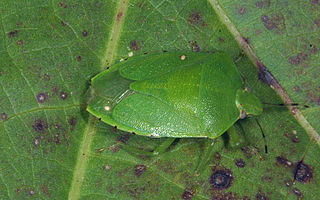
The green stink bug or green soldier bug is a stink bug of the family Pentatomidae.

The hawthorn shield bug is a common European shield bug. Its chief food is haws, the fruit of the hawthorn tree, but adults can overwinter on a diet of leaves, and individuals can be found on many potential food plants, including pedunculate oak, sessile oak and whitebeam. They may grow up to 17 mm (0.67 in) long, and are camouflaged in shades of green and brown. Like many so-called "stink bugs", they may release unpleasant odours when disturbed.

Rhaphigaster nebulosa, common name mottled shieldbug, is a species of stink bugs in the family Pentatomidae. It is the only species of the genus Rhaphigaster.

The birch shieldbug is species of shield bug in the Acanthosomatidae family. Shield bugs are often called "stink bugs" because they excrete a foul smelling liquid that is used to deter predators.

Picromerus bidens, the spiny shieldbug or spiked shieldbug, is a carnivorous species of shield bug in the family Pentatomidae.

Dolycoris baccarum, the sloe bug or hairy shieldbug, is a species of shield bug in the family Pentatomidae.

Eurydema oleracea is a species of shield bug in the family Pentatomidae and is commonly known as the rape bug, the crucifer shield bug, the cabbage bug or the brassica bug.

Nezara viridula, commonly known as the southern green stink bug (USA), southern green shield bug (UK) or green vegetable bug, is a plant-feeding stink bug. Believed to have originated in Ethiopia, it can now be found around the world. Because of its preference for certain species of legumes, such as beans and soybeans, it is an economically important pest on such crops.
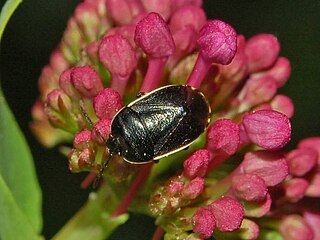
Canthophorus dubius is a species of burrowing bugs or negro bugs belonging to the family Cydnidae, subfamily Sehirinae.

Eurydema ventralis is a shield bug of the family Pentatomidae, subfamily Pentatominae. The species was first described by Friedrich August Rudolph Kolenati in 1846.

Stagonomus venustissimus, common name woundwort shieldbug, is a species of shieldbug belonging to the family Pentatomidae, subfamily Pentatominae.
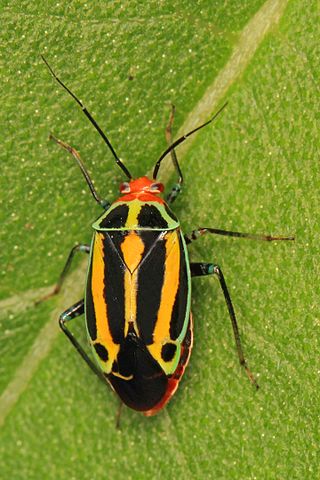
Poecilocapsus lineatus, commonly known as the Fourlined Plant Bug, is a species of true bug (Hemiptera) in the family Miridae. This species is native to the United States and Canada.
Elasmostethus tristriatus is a species of bugs in Shield bug family. The species are green coloured with pinkish-red corium. They are 9–10.5 millimetres (0.35–0.41 in) in length and are active during warm months. They mate during spring. The larvae feed on berries, while adults feed on juniper. They also feed on Lawson's cypress.

Peribalus strictus, common name Vernal Shieldbug, is a species of shield bugs in the family Pentatomidae.

Euthyrhynchus floridanus, the Florida predatory stink bug, is a species of carnivorous shield bug in the family Pentatomidae, the only species in the genus Euthyrhynchus. It is native to the hottest parts of the southeastern United States and is considered beneficial because it feeds on many species of pest insects. They also feed on things such as grasshoppers and other small insects. This species also hunts in a pack, with up to twelve.

Dictyotus caenosus, commonly known as the brown shield bug, is an Australian species of stink bug that has been introduced into New Zealand and New Caledonia.

Cuspicona simplex, commonly known as the green potato bug, is a herbivorous species of stink bug native to Australia and introduced to New Zealand. It feeds on nightshades, and is primarily known as a pest of potatoes, tomatoes, and other crops in the nightshade family.




